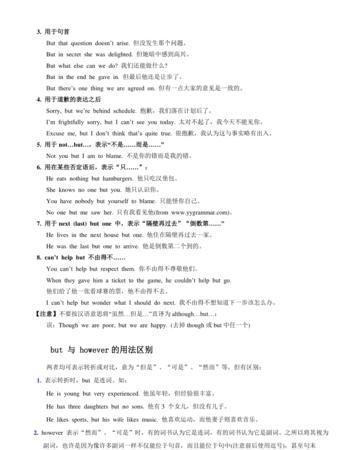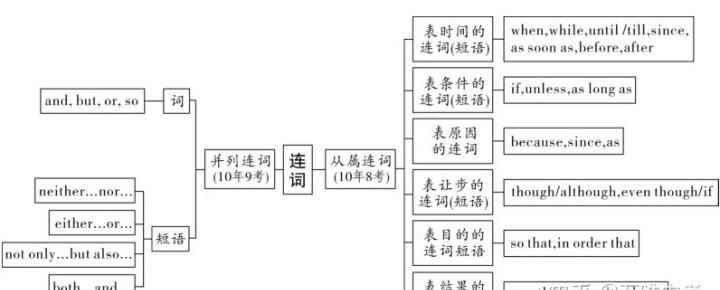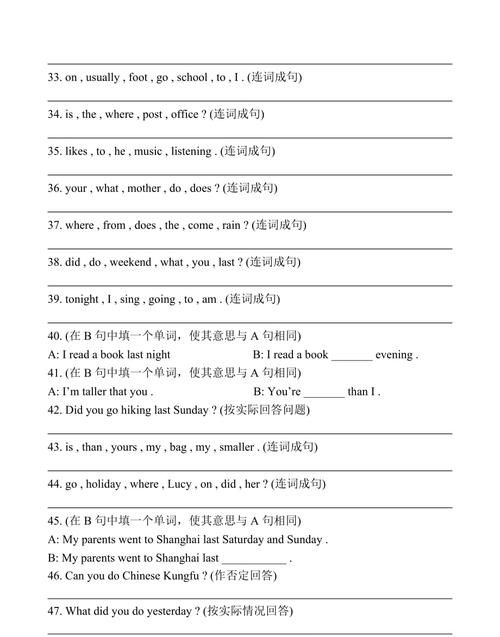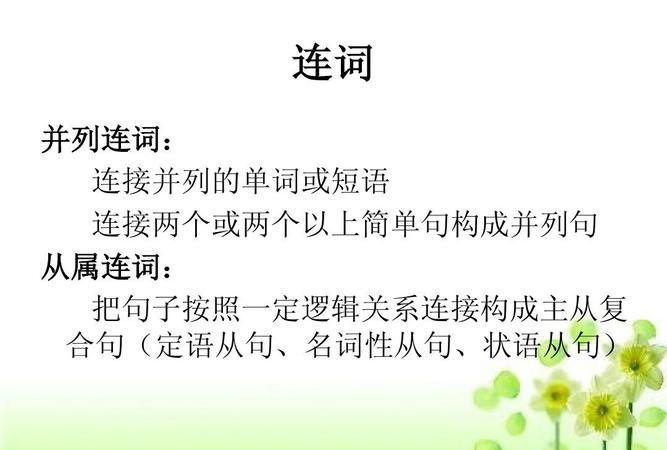本文目录
英语什么是连词成句
连词是用来连接词与词、词组与词组或 句子 与句子、表示某种逻辑关系的虚词。连词可以表并列、承接、转折、因果、选择、假设、比较、让步等关系。
连词(conj conjunction)是一种虚词, 它不能独立担任句子成分而只起连接词与词, 短语 与短语以及句与句的作用。连词主要可分为4类:并列连词.转折连词.选择连词和因果连词。连词也可以分为2类:并列连词和从属连词
并列连词用来连接平行的词、词组和分句、句子。如:
and(和,与;而且;于是,然后;因此)
but(但是;通常用not...but...不是...而是...;可是,然而;表示惊讶,不同意等--喔,哇;用来加强语句重复部分的语气--一定;用来引入新话题--那就;常用于否定句--而不,若不;用于含doubt,question等字的否定句中相当于that--对于),
or(或者,还是;用于否定句或问句--也不;否则,要不然;也就是说,换言之),
nor(用在neither之后--也不;用在no,not,never之后--也不;用在句首,句子需倒装--也不),
so(因此,所以;因而,从而),
therefore(因此,因而,所以),
yet(可是,却,然而),
however(然而,可是,不过;无论如何,不管怎样;不管用什么 方法 ;究竟怎样,到底如何),
for(因为,由于),
hence(因此,由此),
as well as(不但,而且;和...一样,和,也),
both…and(既...又...;不但...而且),
not only…but also(不但,而且),
either…or(不是...就是;要么...要么),
neither…nor(既不...也不...),
(and)then(那么)等等。
并列连词与并列结构
并列连词引导两个并列的句子。
1)and 与or
判断改错:
(错) They sat down and talk about something.
(错) They started to dance and sang.
(错) I saw two men sitting behind and whisper there.
(对) They sat down and talked about something.
(对) They started to dance and sing.
(对)I saw two men sitting behind and whispering there.
解析:
第一句:and 连接两个并列的谓语,所以 talk 应改为 talked。
第二句:and 连接两个并列的动词不定式,第二个不定式往往省略to,因此sang 应改为 sing。
第三句:and 连接感观动词saw 后面的用作的宾补的两个并列分词结构,因此whisper应改为whispering。
注意:and 还可以和祈使句或名词词组连用表示条件。(or也有此用法)
Make up your mind,and you'll get the chance.
= If you make up your mind,you'll get the chance.
One more effort,and you'll succeed.
= If you make one more effort,you'll succeed.
2)both …and两者都
She plays (both) the piano and the guitar.
3)not only…but ...as well as=not only...but also不但…而且
She plays not only the piano,but (also) the guitar.
注意:not only… but also 关联两个分句时,一个分句因有否定词not 而必须倒装
Not only does he like reading stories,but also he can even write some.
4)neither…nor意思为"既不……也不……"谓语动词采用就近原则,与nor后的词保持一致。
Neither you nor he is to blame.
表示选择的并列结构
1)or意思为"否则"。
I must work hard,or I'll fail in the exam.
我必须努力学习,否则我的考试成绩将要下降.
2)either…or意思为"或者……或者……"。注意谓语动词采用就近原则。
Either you or I am right.
或者是你对,或者是我对.
表示转折或对比
1) but表示转折,while表示对比。
Some people love cats,while others hate them.
典型例题
Would you like to come to dinner tonight
I'd like to,___ I'm too busy.
A. and B. so C. as D. but
答案D。but与前面形成转折,符合语意。而表并列的and, 结果的so,原因的as都不符合句意。
2)not…but…意思为"不是……而是……"
not 和but 后面的用词要遵循一致原则。
They were not the bones of an animal,but (the bones) of a human being.
表示让步
however表让步,译为"无论如何"
However we adopt healthcare reform, it isn't going to save major amounts of money.
不管我们采取何种医疗改革 措施 ,都省不下太多钱。
误区提示:however可以表示转折,译为"然而;不过;仍然"但是这时为副词词性,而并非连词。
例句:
This was not an easy decision. It is, however, a decision that we feel is dictated by our duty...
这很难抉择。不过,我们觉得自己有义务作出决定。
表原因关系
1)for
判断改错:
(错) For he is ill,he is absent today.
(对) He is absent today,for he is ill.
for是并列连词,不能置于含两个并列分句的句子的句首,只能将其放在两个分句中间。
2)so,therefore
He hurt his leg,so he couldn't play in the game.
3)because
I cannot sleep because I am too excited.
注意:
这两个词的意思很相近,通常是可以互换使用的。为了安全起见,最好用because引导从句,因为同 because引导的从句相比,for引导的从句的用法要受到某些限制:
①for引导的从句不能位于它所解释的动词之前:
Because it was wet be took a taxi.
因为下雨,他叫了一辆出租车。(这里不能用for)
②for引导的从句不能位于not,but或任何连词之后
③for引导的从句不能用于回答问题:
—Why did you do it? 你为什么这么做?
—I did it because I was angry. 因为我生气才这么做的。(这里不能用for)
④for引导的从句不能单单用来复述已讲过的话,而必须包括新的内容:
He spoke in French. 他讲法语。
She was angry because he had spoken in French. 因为他讲法语,她生气了。

英语中连词是什么词性
连词实际上就是将同等含义的意思连接在一起,或者是递进含义的词汇连接在一起,比如and,so等等,and是将同等含义的词连接在一起,so是将递进含义的词连在一起

在英语中连词到底是什么词性
英语有48万6000个左右的单词,而连词却只有70个左右,它们总是非常高频率的出现在各类文章、对话、电邮等英语实际沟通中,像胶水一样将相关联的句子连接起来,国际心理学家、语言学家、教育家Chris Lonsdale 又把它称之为“胶水词”。胶水词就像英语的骨架一样重要,学会了胶水词,同时拥有词组的累积,你就可以轻松灵活的造出任何需要的长句,让你的英文交流如鱼得水。
连词是一种虚词,用于连接单词、短语、从句或句子,在句子中不单独用作句子成分。连词按其性质可分为并列连词和从属连词。并列连词用于连接并列的单词、短语、从句或句子,如and, but, or, for等;从属连词主要引出名词性从句(主语从句、宾语从句、表语从句等)和状语从句(时间状语从句、条件状语从句、目的状语从句等),引出名词性从句的连词如that, whether等,引出状语从句的连词如when, because, since, if 等。另外,还有些并列连词词组,如: both…and…、either…or…、neither…nor…、not only…but also…、not only…but also…和对称结构 。

英语连词是什么意思
一、概说
连词是一种虚词,用于连接单词、短语、从句或句子,在句子中不单独用作句子成分。连词按其性质可分为并列连词和从属连词。并列连词用于连接并列的单词、短语、从句或句子,如and, but, or, for等;从属连词主要引出名词性从句(主语从句、宾语从句、表语从句等)和状语从句(时间状语从句、条件状语从句、目的状语从句等),引出名词性从句的连词如that, whether等,引出状语从句的连词如when, because, since, if 等。
二、并列连词的用法
◆ 1. 表示转折关系的并列连词。这类连词主要有 but, yet 等。如:
Someone borrowed my pen, but I don’t remember who. 有人借了我的钢笔,但我不记得是谁了。
He said he was our friend, yet he wouldn’t help us. 他说他是我们的朋友,但却不肯帮助我们。
◆ 2. 表示因果关系的并列连词。这类连词主要有 for, so 等。如:
The child had a bad cough, so his mother took him to the doctor. 这孩子咳得很利害,所以他妈妈带他去看医生。
You are supposed to get rid of carelessness, for it often leads to serious errors. 你们一定要克服粗枝大叶,因为粗枝大叶常常引起严重的错误。
注意:for表示结果通常不能放句首,也不能单独使用。
◆ 3. 表示并列关系的并列连词。这类连词主要有 and , or , either…or , neither…nor , not only…but (also) , both…and , as well as 等。如:
He didn’t go and she didn’t go either. 他没去,她也没去。
The weather is mild today; it is neither hot nor cold. 今天天气很温暖,不冷也不热。
Both New York and London have traffic problems. 纽约和伦敦都存在交通问题。
It is important for you as well as for me. 这对你和对我都很重要。
People who are either under age or over age may not join the army. 年龄不到或者超龄的人都不得参军。
三、从属连词的用法
◆ 1. 引导时间状语从句的从属连词
(1) 表示“当…时候”或“每当”的时间连词。主要的 when, while, as, whenever。如:
Don’t talk while you’re eating. 吃饭时不要说话。
Vegetables are best when they are fresh. 蔬菜新鲜时最好吃。
He came just as I was leaving. 我正要走时他来了。
(2) 表示“在…之前(或之后)”的时间连词。主要的有before, after。如:
Try to finish your work before you leave. 离开前设法把工作做完。
After we have finished tea, we will sit on the grass. 喝完茶之后我们将坐在草地上。
(3) 表示“自从”或“直到”的时间连词。主要的有since, until, till。如:
She’s been playing tennis since she was eight. 她从八岁起就打网球了。
Hold on until I fetch help. 坚持一下,等我找人来帮忙。
Never trouble trouble till trouble troubles you. (谚)不要无事惹事。
(4) 表示“一…就”的时间连词。主要的有as soon as, the moment, the minute, the second, the instant, immediately, directly, instantly, once, no sooner…than, hardly…when等。如:
I’ll let you know as soon as I hear from her. 我一接她的信就通知你。
The moment I have finished I’ll give you a call. 我一干完就给你打电话。
I came immediately I heard the news. 我一听到这个消息,马上就来了。
Once you begin you must continue. 你一旦开始, 便不可停下来。
(5) 表示“上次”、“下次”、“每次”等的时间连词。主要的有every time(每次),each time(每次),(the) next time(下次),any time(随时),(the) last time(上次),the first time(第一次)。如:
I’ll tell him about it (the) next time I see him. 我下一次见到他时,我就把这个情况告诉他。
We lose a few skin cells every time we wash our hands. 每当我们洗手的时候,我们都要损失一些皮肤细胞。
You can call me any time you want to. 你随时都可以给我打电话。
注意:every time, each time, any time前不用冠词,(the) next time, (the) last time中的冠词可以省略,而the first time中的冠词通常不能省略。
◆ 2. 引导条件状语从句的从属连词。这类连词主要有if, unless, as [so] long as, in case 等。如:
Do you mind if I open the window?我开窗你不介意吧?
Don’t come unless I telephone. 除非我打电话,否则你别来。
As long as you’re happy,it doesn’t matter what you do. 只要你高兴,你做什么都没关系。
In case it rains they will stay at home. 万一下雨,他们就呆在家里。
注意:在条件状语从句中,通常要用一般现在时表示将来意义,而不能直接使用将来时态。不过,有时表示条件的 if之后可能用 will,但那不是将来时态, 而是表示意愿或委婉的请求(will为情态动词)。如:
If you will sit down for a few moments, I’ll tell the manager you’re here. 请稍坐, 我这就通知经理说您来了。
◆ 3. 引导目的状语从句的从属连词。主要的有 in order that, so that, in case, for fear等。如:
He raised his voice so that everyone could hear. 他提高了嗓音,以便每个人都能听见。
Take your umbrella (just) in case it rains. 带上雨伞,以防下雨。
She repeated the instructions slowly in order that he should understand. 她把那些指示慢慢重复了一遍好让他听明白。
◆ 4. 引导结果状语从句的从属连词。主要的有so that, so…that, such…that等。如:
I went to the lecture early so that I got a good seat. 我去听演讲去得很早, 所以找个好座位。
I had so many falls that I was black and blue all over. 我摔了许多跤,以致于全身都是青一块紫一块的。
He shut the window with such force that the glass broke. 他关窗子用力很大, 结果玻璃震破了。
◆ 5. 引导原因状语从句的从属连词。主要的有because, as, since, seeing (that), now (that), considering (that) 等。如:
He distrusted me because I was new. 他不信任我,因为我是新来的。
As you are sorry,I’ll forgive you. 既然你悔悟了,我就原谅你。
Since we’ve no money, we can’t buy it. 由于我们没钱,我们无法购买它。
Seeing that he’s ill he’s unlikely to come. 因为他病了,他大概不会来了。
Now that she has apologized, I am content. 既然她已经道了歉, 我也就满意了。
◆ 6. 引导让步状语从句的从属连词。主要的有although, though, even though, even if, while, however, whatever, whoever, whenever, wherever等。如:
Although they are twins, they look entirely different. 他们虽是孪生, 但是相貌却完全不同。
I like her even though she can be annoying. 尽管她有时很恼人, 但我还是喜欢她。
You won’t move that stone, however strong you are. 不管你力气多大, 也休想搬动那块石头。
Whatever we have achieved, we owe to your support. 我们取得的一切成就都归功于你们的支持。
Whoever you are, you can’t pass this way. 不管你是谁,你都不能从这里通过。
Whenever I see him I speak to him. 每当我见到他,我都和他讲话。
◆ 7. 引导方式状语从句的从属连词。主要的有as, as if, as though, the way等。如:
Why didn’t you catch the last bus as I told you to? 你怎么不听我的话赶乘末班公共汽车呢?
He bent the iron bar as if it had been made of rubber. 他将铁棍折弯,仿佛那是用橡皮做成的。
Nobody else loves you the way(=as) I do. 没有人像我这样爱你。
◆ 8. 引导地点状语从句的从属连词。主要的有where, wherever, everywhere, anywhere等。如:
The church was built where there had once been a Roman temple. 这座教堂盖在一座罗马寺庙的旧址。
I’ll take you anywhere you like. 你想到哪儿我就带你到哪儿。
Everywhere I go,I find the same thing. 不管我走到哪里,我都发现同样情况。
◆ 9. 引导比较状语从句的从属连词。主要的有than和as…as。如:
She was now happier than she had ever been. 现在她比过去任何时候都快活。
I glanced at my watch. It was earlier than I thought. 我看了看表,时间比我想像的早。
He doesn’t work as hard as she does. 他工作不像她那样努力。
◆ 10. 引起名词从句的从属连词。主要有that, whether, if 等,它们用于引导主语从句、表语从句、宾语从句和同位语从句。其中that 不仅没不充当句子成分,而且没有词义,在句子中只起连接作用;而 if, whether 虽不充当句子成分,但有词义,即表示“是否”。如:
He replied that he was going by train. 他回答说他将坐火车去。
I wonder if it’s large enough. 我不知道它是否够大。
I worry about whether I hurt her feelings. 我为是否伤了她的感情而担心

以上就是关于英语连词是什么意思,英语什么是连词成句的全部内容,以及英语连词是什么意思 的相关内容,希望能够帮到您。
